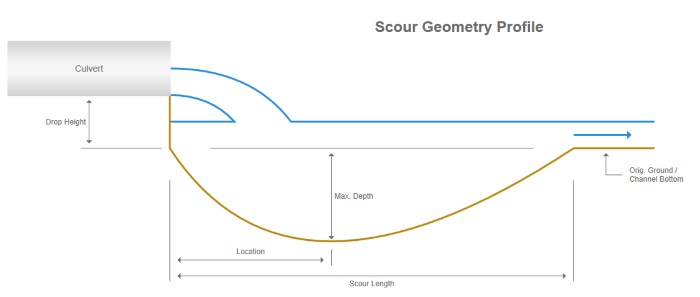
Culvert Studio can estimate local scour at the outlet of your culvert. That is, the depth produced by scour, the total length of the scour, and its location.
Scour is based on discharge, culvert shape, soil type, duration of flow, culvert slope, drop height (height above the natural bed) and tailwater depth. The software uses the computational procedures outlined in Hydraulic Engineering Circular 14 – “Energy Dissipators”. Culvert Studio assumes a fixed time duration of 30 minutes (industry standard).

Scour Input Requirements
The inputs for scour are very minimal, in fact they are optional and can be disregarded if desired. In any case, the software will automatically compute dimensions for a protective riprap apron.
Drop Height
Enter the vertical distance from the culvert invert to the original natural bed. Can be between zero and 4 x Culvert Rise.
 Soil Type
Soil Type
Choose from the drop-down list box Cohesionless (sand or gravel) or Cohesive (clay).
Soil – (D84/D16)^.5
Material Standard Deviation. (Cohesionless soils only). This value is determined by performing a grain-size distribution sieve analysis per ASTM DA22-63. Typical values are 2.10 for gravel and 1.87 for sand.
Shear Strength
(Cohesive soils only). Enter the saturated shear stress resulting from an unconfined compressive test (ASTM D211-66-76). A typical value is 500 lbs./sf (24,000 N/sqm).
Plasticity Index (PI)
(Cohesive soils only). Enter the PI resulting from Atterburg limits test (ASTM D423-36). Allowable values range from 5 to 16.
Scour Outputs
If Scour data was input, you will see a computed profile like this.

Scour Geometry Numerical Outputs
The Results Grid will include the geometry data as follows:
Length
Total length of the scour hole. Shown above to be 19.81 ft.
Width
Width of the scour hole at the widest point.
Depth
Maximum depth of the scour hole. Shown above to be 4.26 ft.
Location
The distance from the end of the culvert to the maximum depth. Shown above to be at 8.0 ft.
Volume
The total volume of the scour hole.
It should be noted that the scour methodologies were developed by tests conducted by the Corps of Engineers and Colorado State University. The computational methods and equations are presented in HEC-14 and are considered to be worst-case scour geometries. Also, Culvert Studio assumes a time duration of 30 minutes.
Designing a Culvert Riprap Apron
Culvert Studio automatically designs riprap protection aprons, independent of the scour inputs. It employs the methods presented in HEC-14. It provides finished plan and profile views.

Click the Plan link at the bottom of the drawing to view the Apron Plan.

Apron Design Numerical Outputs
Length
The total required length of the apron. Will be increased to accommodate projected water flow from Drop Height > 0.
Width
The width of the apron at the most downstream end. The width at the culvert outlet is drawn to: Culvert Span x No. Barrels + 2 x Span.
Depth
The required depth of the riprap. DO NOT take this design parameter lightly. The depth of your riprap is important but commonly gets neglected in the field.
D50
The required rock size.
Velocity
The velocity of the flow at the downstream end of the apron. This is computed by assuming critical depth at the apron end.
Class
Class of riprap developed by the FHWA Federal Lands Highway Division, 2003.
